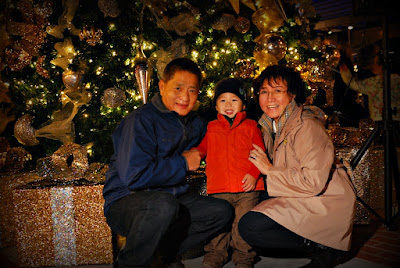
When the ambient light is dim, balancing flash and ambient can be done in a few ways depending on how dim the ambient light is.
AMBIENT NOT TOO DIM:
1. If the ambient is not too dim, you can either use a wider aperture, a longer shutter speed, a higher ISO, or any combination of the above to set the ambient light at the level you want.
2. Take a test shot with flash. If you're in TTL, the camera will set the flash exposure automatically based on the exposure settings you chose to achieve a more-or-less correct flash exposure.
3. Adjust the flash exposure as needed using flash exposure compensation.
The procedure above can also be used with manual flash except that instead of step 2 and step 3, you set the power level yourself such that you get the flash exposure you want.
There are some limits to the general procedure above:
1. Subject correctly exposed by ambient light: If you choose an ambient exposure that also makes the subject correctly exposed (such as when the subject and ambient are about equal in brightness to begin with), then adding flash will result in overexposure of the subject. To remedy this underexpose the ambient by at least 1/3 stop, if not 1 stop.
2. Flash blur. If the subject is almost correctly exposed from the ambient, and you use a slow shutter speed, flash blur will likely occur.
3. Minimum flash power. The flash has a minimum power output. If the aperture is very wide, the ISO is very high, the subject is very close to the flash, or any combination of the foregoing, it is possible that even with the flash's minimum power output, the subject will be overexposed. In this kind of situation switch to the second scenario below (ambient very dim).
AMBIENT VERY DIM:

If the ambient is very dim, or the flash is too powerful, or both, you can still balance the ambient and the flash with a longer shutter speed.
In the photo of the YN-560 above, I wanted to take a shot will all the LEDs lit (indicating the power level). That meant I had to use the YN-560 on full power and it also meant I had to balance the tremendous amount of light from the YN-560 with the relatively dim LED lights.
I could not simply use a wider aperture or high ISO to bring up the exposure of the LED lights because that would have led to flash overexposure. Indeed, to avoid flash overexposure, I had to set the aperture at f/32 and ISO at 200 (base ISO). The tiny LEDs have no hope of showing up in the photo with those settings -- unless of course I use a slow enough shutter speed. At 1/15 the LEDs actually show up even with such a tiny aperture. I would have preferred to use an even slower shutter speed but I didn't have a tripod and I was shooting from an awkward angle, resulting in my body swaying.
Other things I did for the shot:
1. I used the popup flash to illuminate the YN-560 and the background.
2. To use some of the light from the flash itself to illuminate the flash, I used a couple of sheets of paper as reflectors.
3. The slave sensor of the flash is in front of the flash's body. So as not to have the sensor blocked, I put a AA battery to support the flash just a bit above the carpet.
RELATED RESOURCES:
TTL Flash FAQ
TTL Flash Tutorial
Balancing Flash and Ambient Part 1: Easiest Scenario
Balancing Flash and Ambient Part 2: Sunny Outdoors
No comments:
Post a Comment
Thanks for your comment. It will be published as soon as we get a chance to review it, sorry for that, but we get lots of spam with malicious links.